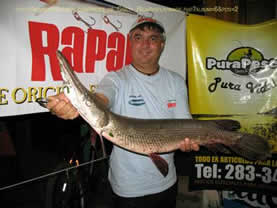The Tropical Gar
Atractosteus Tropicus

Kingdom: Animalia
Phylum: Chordata
Subphylum: Vertebrata
Class: Actinopterygii
Order: Semionotiformes
Family: Lepisoteidae
Genus: Atractosteus
Species: Atractosteus tropicus
Gars are some of the most primitive of the bony fish that hunt, kill, and eat other animals. They bear a strong resemblance to the fossils of gars that lived 75 million years ago. For this reason, some researchers consider the gar an evolutionary link. The southern-most species of gar is the tropical gar. The tropical gar is less well-known than the alligator gar (Atractosteu spatula), even though they share the same family (Lepisosteidae) and genus (Atractosteu).
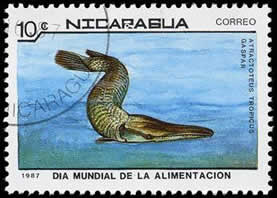
Range and Habitats:
Tropical gars reside in tropical freshwater of the Caribbean and Pacific drainages of Mexico and Central America. They prefer water in the range of 72 to 82F. They can be found in backwaters and in slow-moving parts of rivers, lakes, and shallow lagoons. Sometimes they float on the surface of the water and resemble floating logs.
Life Cycle
Tropical gars eat mostly cichlids and other fish, although they sometimes eat copepods, insects, and plant materials. The lipids in their diet are their principal source of energy.
They usually reach the ability to spawn at about 13-15 inches of total length. They enter shallow lakes on the onset of dry season. They spawn when the rivers flood after heavy rain. The flooding creates a larger shoreline and provides flooded vegetation. Big groups of tropical gar school and emit thousands of eggs in a gelatinous mass into the submerged vegetation. A female may spawn with several males at the same time. Then the adults leave the fry to fend for themselves and return to the river. Incubation lasts 48 to 72 hours. The hatched larvae, which have a pair of brown and yellow lines on their flanks, remain submerged until the yolk sac is absorbed; this usually takes 5 to 10 days. Then they are able to swim freely and feed. Juvenile tropical gars feed at night and primarily eat fish. They grow rapidly, and after two years, they reach reproductive size.
Anatomy
Tropical gars have short, broad snouts with nostrils at the front of the snout. They have long fang-like teeth. The top jaw has two rows of teeth; the bottom, one. Their dorsal and anal fins are placed well back on the body and nearly opposite each other. The vertebral column of the tail bends upward and extends into the upper, larger lobe of the tail fin. The tail is rounded and a little lopsided. Their scales are smooth and shiny and covered with ganoin, an enamel-like substance that protects them. Like some reptiles, their vertebrae have a ball-and-socket structure. They have a modified, vascularized swim bladder, which is connected to the throat and acts as a lung, allowing them to surface and breathe atmospheric air if the water does not have enough oxygen. They are usually brown or olive and may have spots. Their underbelly is a lighter color. They can grow as long as four feet and weigh up to six pounds.
Economic and Cultural Importance
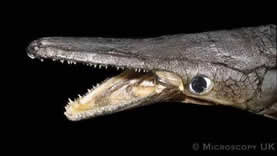
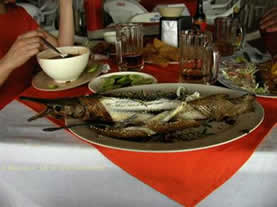
Over-fishing and the popularity of tropical gar as a human food source have caused a decrease in their populations. In South America, there is a large recreational fishing industry for tropical gar. In Tabasco, Mexico, the tropical gar is a popular food because of its nutritional quality and low price. It is served in every seafood restaurant in Tabasco. Tropical gars are also a popular food in Guatemala. As a result, they are now grown in aquaculture facilities to help satisfy the demand.
They are sold as ornamental fish for the aquarium trade, though they are supposedly hard to find.
Some native cultures used the scales as armor, arrowheads and adornment on their tribal dress, and ganoid scales are still used today in making jewelry.
Links
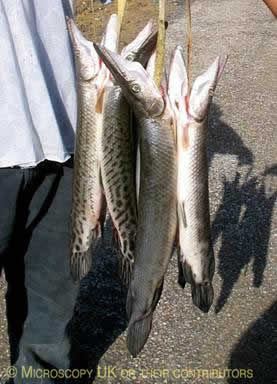
Please note that the following links may have either been removed or relocated by the webpage owners since the time this student report was created.
SFTEP Online - Atractosteus tropicus
References:
Please note that the following references may have either been removed or relocated by the webpage owners since the time this student report was created.
Aguillera, Carlos, Mendoza, Roberto, Rodriguez, Gabino, and Marquea, Gabriel. (2011). Morphological description of alligator gar and tropical gar larvae, with an emphasis on growth indicators. Transactions of the American Fiseries Society 131.5. 899-909. doi: 10.1577/1548-8659(2002)131<0899:MDOAGA>2.0.CO;2
Alfaro, Roberto Mendoza, Gonzalez, Carlos Aquilera, and Ferrara, Allyse M. (2008). Gar Biology and culture: status and prospects. Aquaculture Research 39.7. 748-763. doi:10.1111/j.1365-2109.2008.01927.x
Barrientos-Villalobos, J. and Espinosa de los Monteros, A. (2008), Genetic variation and recent population history of the tropical gar Atractosteus tropicus Gill (Pisces: Lepisosteidae). Journal of Fish Biology, 73: 1919–1936. doi: 10.1111/j.1095-8649.2008.01993.x
Huerta-Ortiz, M., Alvalrez-Gonzalex, Carlos A., Contreras-Sanchez, Wilfrido M., and Goytortua-Bores, Ernesto. (2010). Lipid requirements in tropical gar (Atractosteus torpicus) Juveniles. Academica de Ciencias Biologicas. Retrieved May 28, 2012 from http://pdacrsp.oregonstate.edu/WAS/Alvarez_Gonzales_b.pdf
